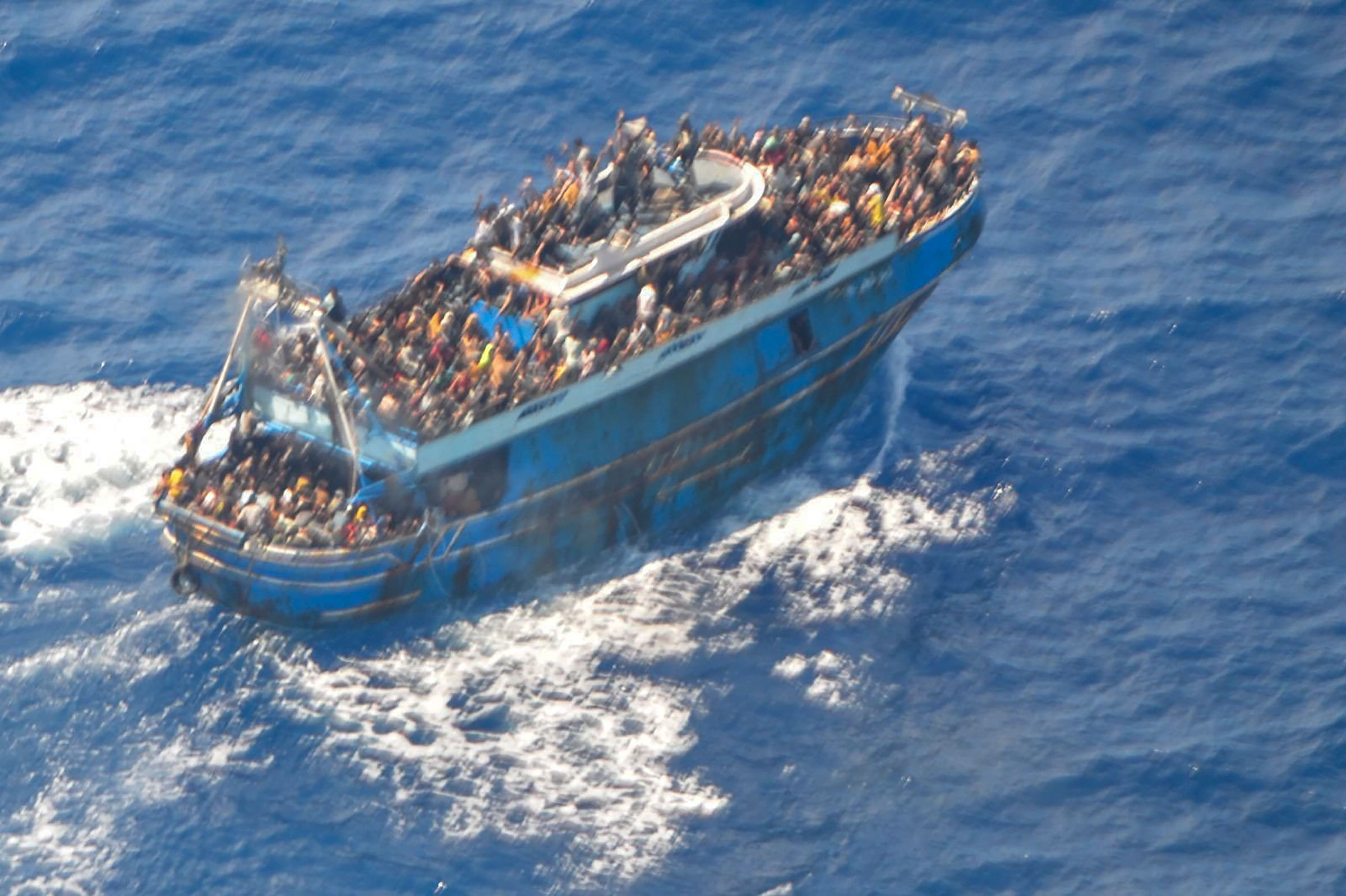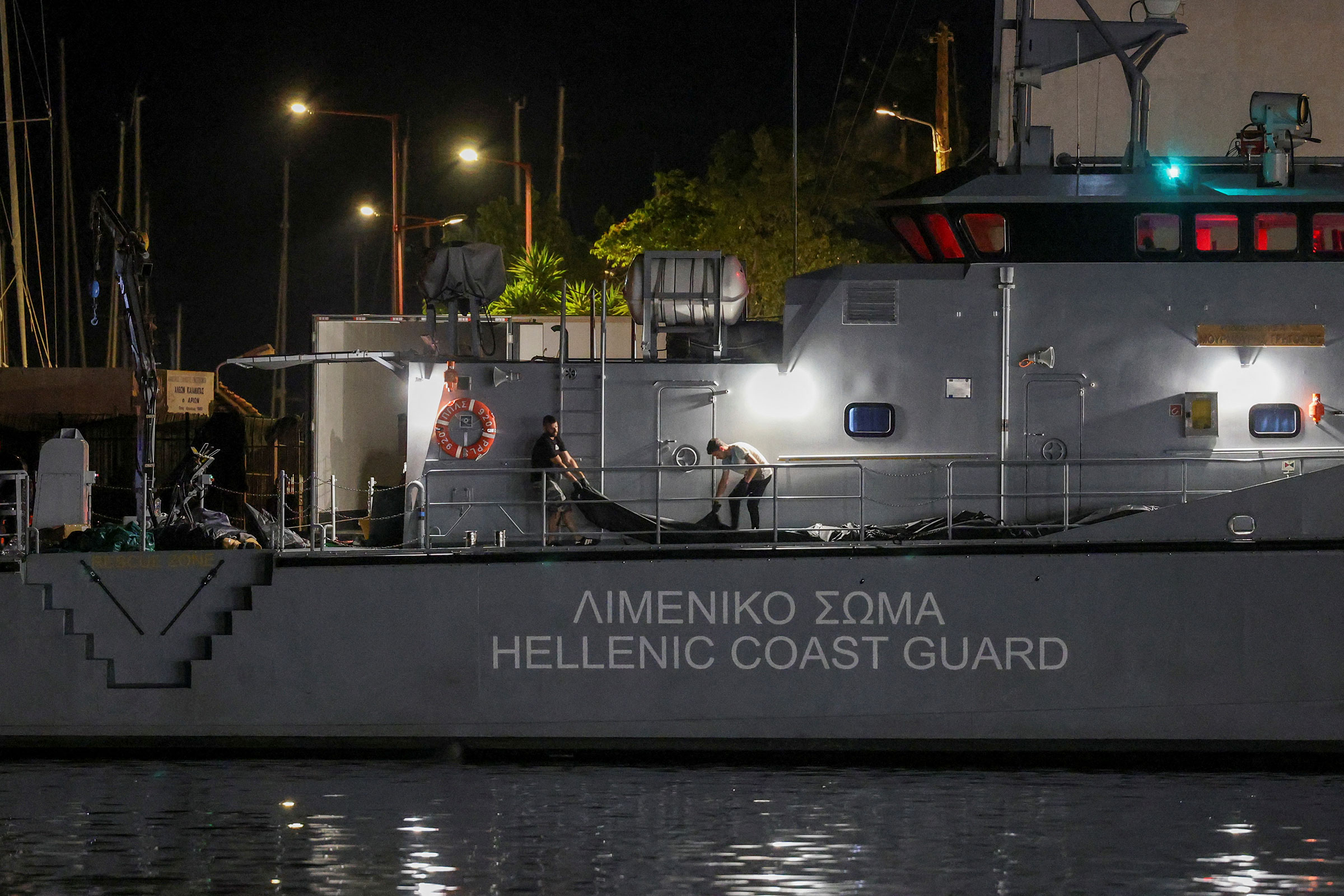
Rescuers fanned out off the coast of Greece on Thursday after at least 78 people died when a fishing boat carrying hundreds of migrants capsized off the southern Peloponnese in the early hours of Wednesday morning.
The fishing boat may have been carrying as many as 750 people, of which around 100 were children, according to survivors. Only 104 individuals have been rescued and taken to shelter as of Thursday and experts say it’s unlikely anyone else will be found alive.
Greek authorities cited the incident as one of the largest migrant tragedies ever recorded on the central Mediterranean migration route. The E.U.’s border agency, Frontex, spotted the boat Tuesday—which was packed with passengers who weren’t wearing life jackets—and alerted Greek and Italian authorities. Officials say the boat’s engine likely stopped working or ran out of fuel and began to veer off course before sinking at around 2 a.m. local time 50 miles south-west of Pylos, a town in southwestern Greece.
“It’s one of the biggest [search] operations ever in the Mediterranean,” Greek coastguard spokesman Nikos Alexiou told state ERT TV of the ongoing search effort, Al Jazeera reported. “We won’t stop looking,” he added. Overnight, six coastguard vessels, navy frigate, and other military transport were utilized in the rescue, but efforts have been hindered by strong winds.
Survivors were taken to the port city of Kalamata, where many are being treated for hypothermia and dehydration. Meanwhile, the bodies of the deceased have been moved to Athens where the identification process will begin with the help of relevant embassies.
As the search continues, here’s everything we know about the capsized boat.

What happened to the boat?
The boat, around 20 to 30 meters in length (65 ft. to 98 ft.)—as per aerial pictures released by the coast guard—was believed to be making its way from Libya to Italy carrying Egyptian, Syrian, Pakistani, Afghan, and Palestinian passengers, most of them young men. The boat had been traveling for a few days, according to local media.
The Greek coastguard provided a timeline of the boat’s movements, according to the BBC. Initial contact by the Greek shipping ministry was made with the boat at 2 p.m. local time on Tuesday and no request for help had been made. It was then approached by a Maltese cargo ship and supplied with food and water at around 6 p.m. At around 1:40 a.m on Wednesday, the coast guard was alerted by someone that the boat’s engine had malfunctioned and the boat was capsizing. It took around fifteen minutes for the boat to fully submerge.

Reuters reported that Alarm Phone, which operates a Europe-wide network supporting rescue operations, received alerts from people aboard the ship on late Tuesday. The volunteer-run project also said the captain fled the ship on a small boat.
Is this the Mediterranean’s deadliest shipwreck?
The Mediterranean’s deadliest recorded shipwreck took place on April 18, 2015; an overcrowded fishing boat, carrying as many as 1,100 migrants, collided off the coast of Libya with a ship that was trying to provide support. Only 28 people survived the collision. A record number of deaths were recorded that year in the Mediterranean, with 3,771 migrants and refugees perishing while trying to reach Europe.
The U.N.’s International Organization for Migration has recorded more than 26,000 deaths or disappearances in the Mediterranean since 2014, including over 20,000 along the Central Mediterranean route, making it the world’s deadliest one.
Read More: The Inspiring True Story Behind Netflix’s The Swimmers

How are officials and aid workers responding?
Greek President Katerina Sakellaropoulou has since visited rescued people and expressed sorrow for those who died. Greece currently has a caretaker government pending a runoff election on June 25, but politicians are halting their campaigns out of respect. A legal investigation has also been called to look into the circumstances of the deaths.
The Greek shipping ministry has said nine Egyptians were arrested over the shipwreck. According to witnesses, Greek Skai TV reported, the ship departed from Egypt before stopping at the Libyan port city of Tobruk, and then set sail to Italy.
Meanwhile, Ursula von der Leyen, the European Commission President, said she is “deeply saddened” by the news and pledged further cooperation between the E.U. and neighboring countries to crack down on migrant smuggling practices.
But rights groups are criticizing the E.U. policies that they say force migrants to take life-threatening routes. “It’s really shocking to hear that Frontex flew over the boat and no one intervened because the boat refused all offers of help,” Jérôme Tubiana, a humanitarian researcher at Doctors Without Borders told French radio, adding that European and Greek authorities should both have intervened earlier. “An overloaded boat is a boat in distress.”
“E.U. leaders must urgently expand safe routes so people are not forced onto these deadly journeys. They need to show a far greater degree of willingness to share responsibility with countries of first arrival like Greece and Italy than we saw in the recent New Pact negotiations,” said Eftychia Georgiadi, head of programs at the International Rescue Committee’s Greece office.
She added: “It’s time to finally forge a coherent European approach to asylum and migration that puts the protection of its people at its heart. If they fail to do so, many in desperate need of protection will continue to perish in the Mediterranean.”
On Thursday, thousands of protesters gathered in Athens and in Thessaloniki calling on the E.U. to relax its migration policies. In Kalamata, Reuters reported, protesters marched outside a migrants’ shelter. “Crocodile tears! No to the EU’s pact on migration,” one banner read.
More Must-Reads From TIME
- The 100 Most Influential People of 2024
- Coco Gauff Is Playing for Herself Now
- Scenes From Pro-Palestinian Encampments Across U.S. Universities
- 6 Compliments That Land Every Time
- If You're Dating Right Now , You're Brave: Column
- The AI That Could Heal a Divided Internet
- Fallout Is a Brilliant Model for the Future of Video Game Adaptations
- Want Weekly Recs on What to Watch, Read, and More? Sign Up for Worth Your Time
Write to Armani Syed at armani.syed@time.com